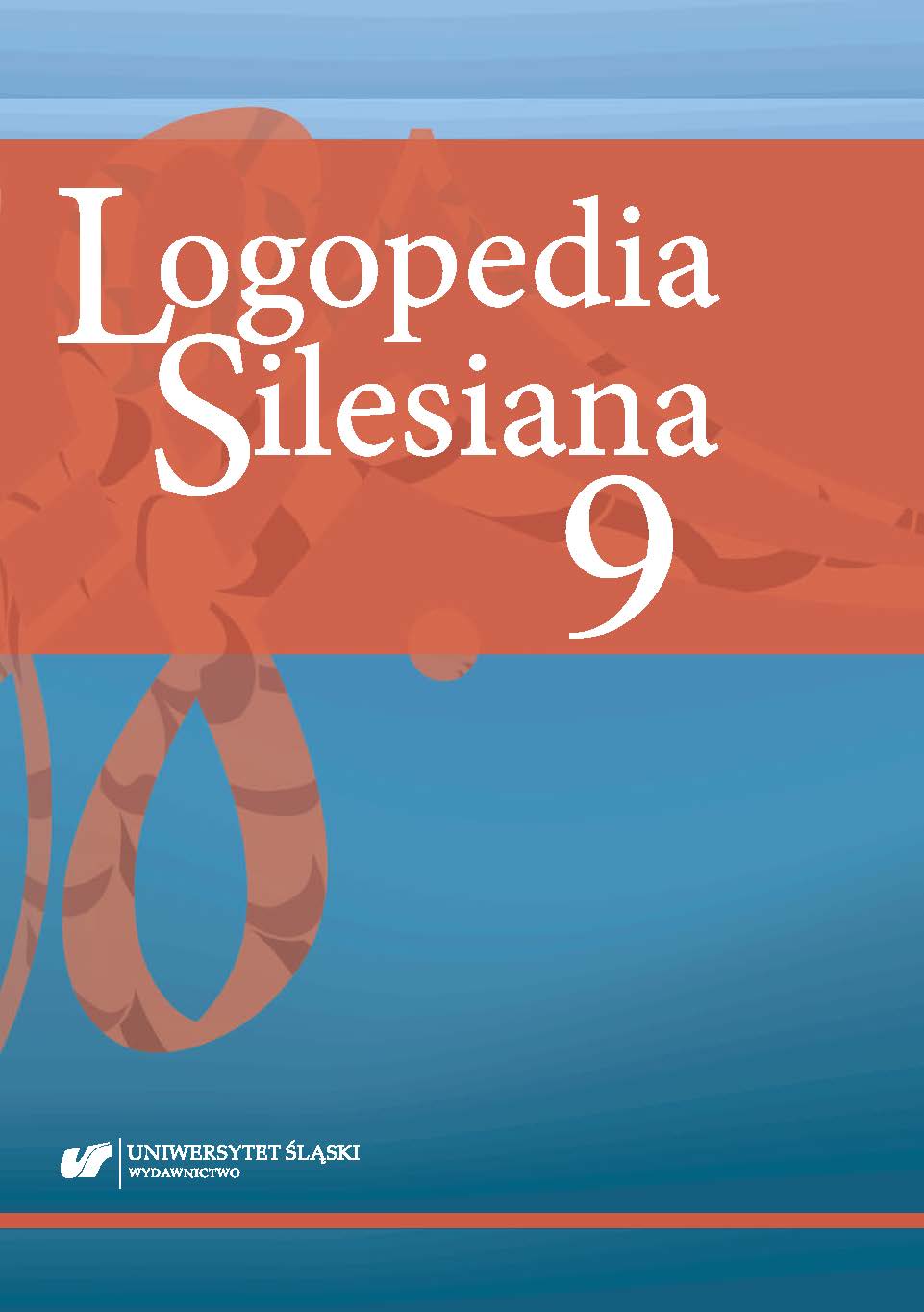Błeszyński, J.J. (2010). Analiza różnicująca wybranych zespołów zaburzeń autystycznych. Zarys rewalidacji. Toruń: Wydawnictwo Naukowe Uniwersytetu Mikołaja Kopernika.
Google Scholar
Błeszyński, J.J. (2014). Biologiczne uwarunkowania rozwoju komunikacji – mowy i języka dzieci z całościowymi zaburzeniami rozwoju: autyzmem i zespołami ze spektrum autyzmu. W: S. Milewski, J. Kuczkowski, K. Kaczorowska-Bray (red.), Biomedyczne podstawy logopedii (s. 311–329). Gdańsk: Harmonia Universalis.
Google Scholar
Bobkowicz-Lewartowska, L. (2011). Autyzm dziecięcy. Zagadnienia diagnozy i terapii. Kraków: Impuls.
Google Scholar
Borkowska, A.R., Robak, A. (2016). SLI a afazja/dysfazja rozwojowa i dziecięca afazja nabyta – ujęcie neuropsychologiczne. W: K. Kaczorowska-Bray, S. Milewski (red.), Wczesna interwencja logopedyczna (s. 247–259). Gdańsk: Harmonia Universalis.
Google Scholar
Bronk, D., Meslin, A. (2017). Rozwój mowy u dziecka z autyzmem. W: D. Marzec, J. Miękina (red.), Autyzm wyzwaniem XXI wieku (s. 56–73). Częstochowa: Wydawnictwo Akademii im. Jana Długosza.
Google Scholar
Chojnicka, I., Płoski, R. (2012). Polska wersja wywiadu do diagnozowania autyzmu ADI-R (Autism Diagnostic Interview – Revised). Psychiatria Polska, 46(2), 249–259.
Google Scholar
Czaplewska, E. Kaczorowska-Bray, K. (2005). Kompetencja komunikacyjna i jej zaburzenia u dzieci. W: M. Młynarska, T. Smereka (red.), Logopedia. Teoria i praktyka (s. 448–454). Wrocław: A Linea.
Google Scholar
Grabias, S. (2012). Teoria zaburzeń mowy. Perspektywy badań, typologie zaburzeń, procedury postępowania logopedycznego. W: S. Grabias, M. Kurkowski (red.), Logopedia. Teoria zaburzeńmowy (s. 15–73). Lublin: Wydawnictwo Uniwersytetu Marii Curie-Skłodowskiej.
Google Scholar
Grycman, M. (2004). Teoretyczne podstawy komunikacji wspomagającej i alternatywnej. W: M. Grycman, A. Smyczek (red.), Wiem, czego chcę! Doświadczenia polskich terapeutów i użytkowników wspomagających sposobów porozumiewania się (AAC) (s. 13–22). Kraków: Stowarzyszenie „Mówić bez Słów”.
Google Scholar
Hycnar-Kamińska, M. (2017). MÓWik jako narzędzie komunikacji wspomagającej i alternatywnej. W: D. Marzec, J. Miękina (red.), Autyzm wyzwaniem XXI wieku (s. 106–117). Częstochowa: Wydawnictwo Akademii im. Jana Długosza.
Google Scholar
Iwańczak, H. (2017). Mowa i komunikacja w autyzmie. W: D. Marzec, J. Miękina (red.), Autyzm wyzwaniem XXI wieku (s. 74–86). Częstochowa: Wydawnictwo Akademii im. Jana Długosza.
Google Scholar
Janik, I. (2012). Mutyzm dziecięcy. W: J. Skibicka, D. Larysz (red.), Neurologopedia w teorii i praktyce. Wybrane zagadnienia diagnozy i terapii dziecka (s. 79–94). Bielsko-Biała: Wydawnictwo Naukowe Akademii Techniczno-Humanistycznej.
Google Scholar
Kaczmarek, B.B. (2014). Zamiast wstępu. Koncepcje polskiego programu Makaton. W: B.B. Kaczmarek (red.), Makaton w rozwoju osób ze złożonymi potrzebami komunikacyjnymi (s. 13–37). Kraków: Impuls.
Google Scholar
Kaniecka, K. (2008). Picture Communication Symbols. W: J.J. Błeszyński (red.), Alternatywne i wspomagające metody komunikacji (s. 353–362). Kraków: Impuls.
Google Scholar
Kielar-Turska, M. (2012). Rozwój sprawności językowych i komunikacyjnych. W: E. Czaplewska, S. Milewski (red.), Diagnoza logopedyczna. Podręcznik akademicki (s. 15–63). Sopot: Gdańskie Wydawnictwo Psychologiczne.
Google Scholar
Krzemiński, M. (2015). Komunikacja, emocje, stres, asertywność i empatia. Student wobec wyzwań współczesności. Włocławek: Wydawnictwo Państwowej Wyższej Szkoły Zawodowej.
Google Scholar
Lipski, W. (2015). Standard postępowania logopedycznego w przypadku autyzmu. W: S. Grabias, J. Panasiuk, T. Woźniak (red.), Logopedia. Standardy postępowania logopedycznego (s. 461–516). Lublin: Wydawnictwo Uniwersytetu Marii Curie-Skłodowskiej.
Google Scholar
Loebl, W. (2008). Szkic rozwoju wspomagającej i alternatywnej komunikacji w Polsce. W: J.J. Błeszyński (red.), Alternatywne i wspomagające metody komunikacji (s. 21–31). Kraków: Impuls.
Google Scholar
Minczakiewicz, E.M. (2001). Edukacyjny i pragmatyczny aspekt rozwoju komunikacji u dzieci ze sprzężonymi zaburzeniami rozwoju. W: E.M. Minczakiewicz (red.), Komunikacja – mowa – język w diagnozie i terapii zaburzeń rozwoju u dzieci i młodzieży niepełnosprawnej (s. 26–39). Kraków: Wydawnictwo Naukowe Akademii Pedagogicznej.
Google Scholar
Obrębowski, A. (2014). Biologiczne podstawy mowy. W: S. Milewski, J. Kuczkowski, K. Kaczorowska-Bray (red.), Biomedyczne podstawy logopedii (s. 23–35). Gdańsk: Harmonia Universalis.
Google Scholar
Olechnowicz, H. (2012). Jak uwolnić w dzieciach z autyzmem wrodzone wzorce przywiązania? W: H. Olechnowicz, R. Wiktorowicz (red.), Dziecko z autyzmem. Wyzwalanie potencjału rozwojowego (s. 23–32). Warszawa: Wydawnictwo Naukowe PWN.
Google Scholar
Panasiuk, J. (2016a). Neurologiczne uwarunkowania rozwoju mowy. W: K. Kaczorowska-Bray, S. Milewski (red.), Wczesna interwencja logopedyczna (s. 36–51). Gdańsk: Harmonia Universalis.
Google Scholar
Panasiuk, J. (2016b). Specyficzne zaburzenia rozwoju mowy w diagnozie i terapii logopedycznej. W: K. Kaczorowska-Bray, S. Milewski (red.), Wczesna interwencja logopedyczna (s. 211–246). Gdańsk: Harmonia Universalis.
Google Scholar
Patrzykont, K. (2017). Praktyczne wykorzystanie systemów komunikacji alternatywnej na zajęciach szkolnych i terapeutycznych. W: D. Marzec, J. Miękina (red.), Autyzm wyzwaniem XXI wieku (s. 143–150). Częstochowa: Wydawnictwo Akademii im. Jana Długosza.
Google Scholar
Pilch, A. (2004). Rozmawiamy gestami. W: M. Grycman, A. Smyczek (red.), Wiem, czego chcę! Doświadczenia polskich terapeutów i użytkowników wspomagających sposobów porozumiewania się (AAC) (s. 75–84). Kraków: Stowarzyszenie „Mówić bez Słów”.
Google Scholar
Pisula, E. (2012). Autyzm. Od badań mózgu do praktyki psychologicznej. Sopot: Gdańskie Wydawnictwo Psychologiczne.
Google Scholar
Przybyla, O. (2015). Motoryczne zdolności koordynacyjne w świetle badań nad mową. W: S. Milewski, K. Kaczorowska-Bray (red.), Metodologia badań logopedycznych z perspektywy teorii i praktyki (s. 322–363). Gdańsk: Harmonia Universalis.
Google Scholar
Rynkiewicz, A., Kulik M. (2013). Wystandaryzowane, interaktywne narzędzia do diagnozy zaburzeń ze spektrum autyzmu a nowe kryteria diagnostyczne DSM-5. Psychiatria, 10(2), 41–48.
Google Scholar
Smyczek, A. (2008). Zastosowanie wspomagających i alternatywnych metod komunikacji (AAC approach) w terapii małych dzieci zagrożonych poważnymi zaburzeniami w porozumiewaniu się. W: J.J. Błeszyński (red.), Alternatywne i wspomagające metody komunikacji. Kraków: Impuls.
Google Scholar
Stecko, E. (2002). Zaburzenia mowy u dzieci – wczesne rozpoznawanie i postępowanie logopedyczne. Warszawa: Wydawnictwa Uniwersytetu Warszawskiego.
Google Scholar
Twardowski, A. (2002). Kształtowanie dialogowej kompetencji komunikacyjnej u uczniów niepełnosprawnych intelektualnie. Kalisz–Poznań: Wydawnictwo Instytutu Pedagogiczno-Artystycznego UAM.
Google Scholar
Winczura, B. (2013). Zaburzenia rozwoju mowy i komunikacji u małych dzieci z autyzmem. Dylematy wczesnej diagnozy autyzmu. W: B. Winczura (red.), Dzieci o specjalnych potrzebach komunikacyjnych. Diagnoza – edukacja – terapia (s. 35–51). Kraków: Impuls.
Google Scholar


 https://doi.org/10.31261/LOGOPEDIASILESIANA.2020.09.14
https://doi.org/10.31261/LOGOPEDIASILESIANA.2020.09.14

 10.31261/LOGOPEDIASILESIANA
10.31261/LOGOPEDIASILESIANA